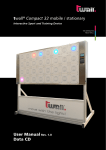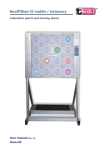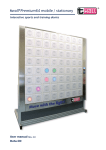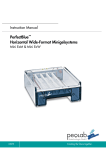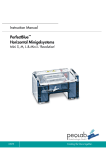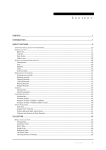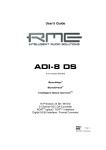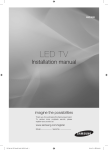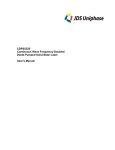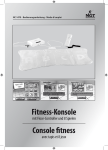Download twall®Basic16 standard Color mobile foldable User Manual Rev. 1.0
Transcript
twall®Basic16 standard Color mobile foldable Interactive Sport and Training Device THE INTERACTIVE TOUCH WALL User Manual Rev. 1.0.2 Data CD twall®Basic16 standard Color mobile foldable | User Manual Rev. 1.0.2 Table of contents: Hardware documentation 1 1.1 Product description---------------------------------------------------------------------------------------- 4 Handling according to regulations-----------------------------------------------------------------------------4 2 Scope of delivery-------------------------------------------------------------------------------------------- 5 3 3.1 Assembly-------------------------------------------------------------------------------------------------------- 6 Installation of the twall®Basic16 Standard Color mobile foldable----------------------------------------6 4 Maintenance--------------------------------------------------------------------------------------------------- 7 5 Troubleshooting--------------------------------------------------------------------------------------------- 8 6 6.1 6.2 Technical specifications----------------------------------------------------------------------------------- 8 Data sheet twall®Basic16 Standard Color mobile foldable------------------------------------------------8 Data sheet - Accessories-----------------------------------------------------------------------------------------8 Software documentation 7 7.1 7.2 7.3 Operating twall® using control panel----------------------------------------------------------------- 9 Executing twall® programs--------------------------------------------------------------------------------------9 Viewing highscores--------------------------------------------------------------------------------------------- 10 Settings----------------------------------------------------------------------------------------------------------- 10 8 8.1 8.2 8.2.1 8.2.2 8.2.3 8.3 8.4 8.4.1 8.4.2 8.4.3 8.4.3.1 8.4.3.2 8.4.4 8.4.5 8.4.6 8.4.7 8.5. Operating twall® using computer---------------------------------------------------------------------11 Connecting twall® to computer------------------------------------------------------------------------------ 11 Driver installation----------------------------------------------------------------------------------------------- 11 Installing drivers using Microsoft Windows XP® - -------------------------------------------------------- 11 Installing drivers using Microsoft Windows Vista®- ------------------------------------------------------ 12 Installing drivers using Windows 7®------------------------------------------------------------------------- 13 Software installation------------------------------------------------------------------------------------------- 14 Software description------------------------------------------------------------------------------------------- 15 The welcome page---------------------------------------------------------------------------------------------- 15 Program settings------------------------------------------------------------------------------------------------ 15 Executing twall® programs------------------------------------------------------------------------------------ 15 Saving programs to twall®------------------------------------------------------------------------------------ 16 Highscores------------------------------------------------------------------------------------------------------- 17 Simulating twall® programs---------------------------------------------------------------------------------- 17 Creating new twall® programs------------------------------------------------------------------------------- 18 Editing twall® programs--------------------------------------------------------------------------------------- 20 Editing Sound sets---------------------------------------------------------------------------------------------- 20 Firmware update------------------------------------------------------------------------------------------------ 21 9 Service----------------------------------------------------------------------------------------------------------23 E| 3 twall®Basic16 standard Color mobile foldable | User Manual Rev. 1.0.2 Hardware documentation 1 Product description The twall® is an interactive sports device using light pulses to specifically initiate motion sequences. At a wall consisting of evenly arranged, large pads, colored signals light up (available separately as well as in combination) and have to be deactivated by touching them again which defines sterical movements. Depending on the training sequence used condition, agility, the ability to respond, and if required specific muscular endurance can be trained. The different elements can be predefined in the program so that they light up in a selective or random sequence, position and speed. The task is always the same: To deactivate the light as quickly as possible by pressing the buttons. The software-controlled program sequences provide both individual training and group training. By controlling each touch element individually it is possible to adjust the twall® training settings according to size, sphere of activity, visual perception as well as the tactile situation of the person trained. Furthermore, product version twall® color allows to integrate cognitive tasks using various colors and sounds. Also, the small construction depth makes it easy to integrate twall® to existing room concepts. 1.1 Handling according to regulations The use of the twall® is intended for training and game purposes of human beings exclusively. It is strictly recommended that the operator checks if the aptitude of the training program suits the training person. The twall® has to be operated by the provided power supply unit only. As a precaution we would like to make you aware of the fact that the twall® control panel generates high frequency, electric oscillations and despite compliance with legal regulations it may effect other electronic devices such as cardiac pacemakers etc. Please be aware that the fastening of the twall® has to be secured on site and is not within the manufacturers obligation. The applicability of the walls should be checked and plasterboard walls should be covered at least twice. Fixing elements such as screw anchors and tie bars must have adequate tensile strength. The fastening should be checked on a regular basis. In the case that fixing elements become loose the twall® must not be used any further until the fastening has been repaired entirely. Continuous operation of a single or all touch pads is not permitted as it can lead to a strong heating of the LED (light-emitting diode) modules. Sequences that force a single or all touch pads to light up for longer than 2 minutes are prohibited and can cause the loss of warranty. 4 |E twall®Basic16 standard Color mobile foldable | User Manual Rev. 1.0.2 2 Scope of delivery 2.1 Overview - scope of delivery of the twall®Basic16 Standard Color mobile foldable A A1g A4 C Accessories (included in scope of delivery) C1 1 x Power supply line (with Euro connector) C2 1 x USB cable (A/B) C3 1 x Adapter (power supply unit) C4 1 x Allen key (6 mm | 0.24 inch) E 1 x twall®Basic16 Standard Color mobile foldable 2 x Angles braces 2 x Weights User manual and data-CD ATTENTION: As you unpack the twall® device, check the scope of delivery and make sure that all items are included. E| 5 twall®Basic16 standard Color mobile foldable 3 | User Manual Rev. 1.0.2 Assembly ATTENTION: Before start-up a period of 1-2 hours is advised for the equipment to acclimatize. Please pay attention to condensation that might appear. 3.1 Installation of the twall® The twall® is delivered completely assembled. (fig. 3.1-1). During transport without a transport case the folded twall® must be secured to prevent them falling and rolled along on a level floor! Strong vibrations must be avoided. The adjustable clamping levers next to the joints shall be tighten slightly. Putting up the twall® requires a firm, lever to surface of at least 2m x 2m, that can carry a weight up to 200kg. In the event, that you have a transport case, please take out the ballast weights, the power supply unit and the angles braces. Afterwards you lift the twall® out of the transport case and put it on the designated position. Make sure to strictly observe the order of the following steps to prevent all moving parts from destruction! I. Opening up the twall : ® fig. 3.1-1 B A D Step Loosen the locking screw A from the transport lock (fig. 3.1-2) and pull the screw upwards until it is justified with the lower edge of the transport lock D. PLEASE NOTE: The transport lock is still fix connected with the twall®. fig. 3.1-2 C Step Undo slide safety clamping levers C on the twall®, push them forwards on both sides (top and bottom) und lock again, when aligned parallel to the twall®-frame (fig. 3.1-3) fig. 3.1-3 Step Now the twall® will be carefully putted into position. For that, place your foot against the lower edge of the frame (fig. 3.1-4) and pull the twall® on the grips apart. Now insert the ballast weights into the rear part of the frame base (fig. 3.1-5). Step Only now remove the transport lock D. (fig. 3.1-2) Abb. 3.1-4 fig. 3.1-5 fig. 3.1-4 6 |E twall®Basic16 standard Color mobile foldable | User Manual Rev. 1.0.2 Step Flip up the upper part from the backside with both hands (fig. 3.1-7), shut the lateral sliders and lock the clamping levers (fig. 3.1-8). Concrete weights and angles braces fig. 3.1-6 II. Attaching the angles braces: Step The braces (fig. 3.1-6) shall be screwed on with the screws M8 (you can already find them in the appropriate threads) and under usage of the provided Allen key 6mm (ca. 25Nm). (fig. 3.1-9) fig. 3.1-7 After installation please check all mounting members for tightness as well as stability of the twall®. III. Establishing operational readiness: Step Connect the voltage connector (attached to the right steel frame) to the 24 Volt connector of the power supply unit. (fig. 3.1-10) IV. Transport case (optional): fig. 3.1-8 fig. 3.1-9 Folding up the twall® takes place in reverse order! At least 2 persons are required for packaging the twall® in an optional available transport case (fig. 3.1-11). Lift the folded twall® up and push it on the rollers towards the rear of the transport case. The braces could be placed down diagonally on the sides, the ballast weights are transported separately. Now hook in the lateral locks and fix them by clockwise rotation. 4 Maintenance fig. 3.1-10 fig. 3.1-11 Every sports device is constantly exposed to dust and sweat. Same applies to the twall®. During frequent use some soil deposit may occur on the surface of the touch elements. To ensure a long life cycle and a maintained appearance please clean the touch elements and the frame at least once a month. In case of more frequent use we recommend twice a month. Please use a soft, lint-free and dry cloth. In case of heavy soiling, the cloth can be used in combination with a mild detergent or disinfectant. ATTENTION: Never use dissolver or gas as this may damage the touch elements. E| 7 twall®Basic16 standard Color mobile foldable 5 | User Manual Rev. 1.0.2 Troubleshooting Potential errors/malfunction source Check if a sufficient power supply is available. Please pay attention that the power supply unit is correctly connected to the twall® and the socket. In case of interruptions, please check if enough space is provided between the sports device and components that generate strong magnetic fields such as loudspeakers or microwaves. Should any liquids or external items get into the inside of the twall® disconnect the twall® from the power supply and contact your service provider. ATTENTION: Additional help will you get from our twall® online support on “www.twall.de”. In the download area (see page 22, Step ,) you can find the relevant documents for specific troubleshooting and correction of errors as well as complaints. 6 Technical Specifications 6.1 Data sheet twall®Basic16 Standard Color mobile foldable Autarkic, multicolored interactive indoor training device twall®Basic16 Standard Color mobile foldable Integrated control panel, 10 preinstalled training programs Graphic program surface to create favored programs 4 x 4 touch elements Active training area in mm | inch (H x W): 880 x 880 | 34.7 x 34.7 Dimension of whole device in mm | inch (H x W x D):1864 x 1202 x 1106 | 73.4 x 47.4 x 43.6 Weight in kg | lbs: approx 125 | 275.6 Up to 7 fluorescent colors (red, green, blue and mixed colours) Frame: stainless steel Touch elements: plastic, color translucent white Power input: 40 W Power supply: 24 V (power supply jack and switch) Connecting socket for power supply and power supply switch Freestanding with transport rollers Maintenance intervals: semi-annual and according to the terms of lease respectively Guarantee 1 year 6.2 Data sheet – Accessories Power supply line (with Euro connector) USB cable (A /B) AC adapter (power supply unit) with barrel connector (fig. 6.2-1) • AC adapter -- Primary: 90-264 V AC; 47-63 Hz -- Secondary: 24 V DC; 5 A -- Dimensions -- (h x w x d in mm |inch): 62 x 35 x 170 | 2.55 x 1.4 x 6.7 -- Weight (in g |lbs): approx. 530 | 1.2 -- Euro connector • Barrel connector (fig. 6.2-2 and fig. 6.2-3) -- Pin 1 and Pin 2 + 24 V -- Pin 3 and Pin 4 - 0V fig. 6.2-1 fig. 6.2-2 fig. 6.2-3 8 |E twall®Basic16 standard Color mobile foldable | User Manual Rev. 1.0.2 Software Documentation 7 Operating the twall® without a computer Using the control unit integrated in the twall® , the twall® can be fully operated without using a computer. To this end, a menu is shown on the display which can be operated using the four orange keys beneath the display. The name of the menu is always displayed in the top line. The menu item currently selected is shown with a black bar with round corners. The arrow to the right of the item indicates that this item is part of a menu which has additional subitems. The functions which can be executed with the operating keys are shown in the bottom line. Use these keys to operate the menu. When navigating the main menu and its submenus, the functions for the operating keys are assigned as follows: The [arrow down] key selects the menu item underneath the one currently selected. The [arrow up ] key selects the menu item above the one currently selected. The [ENTER] key accesses the selected submenu or activates the selected menu item. The [MENU] key exits the current menu. When activating certain menu items, the assignment of the operating keys changes. 7.1 Executing twall® Programmes In order to execute a twall® Programmes by menu, select the menu item "Programmes" in the main menu and confirm this with [ENTER]. You are now in the submenu "programme". The Programmes installed on the twall® are displayed. Select the desired programme using the arrow keys and confirm with [ENTER] to start the programme. The status of the programme is now shown on the display. The name of the loaded programme is always displayed in the top line. This is where the current programme time is displayed. Status line for player 1. The three figures mean: overall targets / targets hit / errors. Status line for player 2. This line is not shown if it is a programme for one player only. E| 9 twall®Basic16 standard Color mobile foldable | User Manual Rev. 1.0.2 The layout of the operating keys is largely identical. The [ENTER] key is replaced in this screen by the [NEW] key with which the programmes can be restarted. The arrow keys load the next and/ or previous Programmesme in the list of twall® Programmes. The time starts to run as soon as the first touch pad on the twall® is pressed. The end of the programme is generally indicated by the brief flashing of all the touch pad. 7.2 Viewing high scores Viewing high scores works in a similar way to implementing programmess. In the main menu, select the menu item "High scores" with [ENTER]. The "High scores" menu immediately opens, in which a list of the installed programmess is displayed. In order to display the high scores for a specific programme, select the programme using the arrow keys and then press [ENTER] to confirm. You can now navigate through the high score list using the arrow keys. A high score is always shown on a screen page. The top line shows the programme to which the high score list relate. The placings are shown here (places 1-10). The name of the player. As on the twall® control unit it is not possible to enter a name, the name "Player" is stipulated automatically. If the twall® is controlled by the computer, other names can also be assigned (see Chapter 9.4.2) The "ID" value shows the sequence of the high score entries. The most recent entry in the lists always has the highest ID. Shown in this line is the playing time of the high score entry. Shorter times produce better placings. 7.3 Settings The "Settings" menu contains the item "Version info" under which the following information regarding the twall® can be accessed: Type of twall® (exact model designation) Hardware version Software version NOTE: Always quote this information when sending a service inquiry to IMM. 10 |E twall®Basic16 standard Color mobile foldable 8 | User Manual Rev. 1.0.2 Operating the twall® with a computer The twall® is fully operational without a computer, using the integrated control unit. However, certain actions, such creating as new programmess, require the use of software. The following chapter describes how this is installed and what steps are necessary for its use. System requirements of the PC: Operation systems Windows 2000/XP/Vista/7 Microsoft .Net Runtime 2.0 (included on software-CD) Processor speed min. 1.0 GHz USB Interface Screen resolution: 1024*768 50 MByte free HDD space keyboard/ mouse NOTE: The twall® drivers/software and firmware are constantly being improved. The current version at any given time can be downloaded in the download area at www.twall.de. For this you need the serial number of your twall® which can be found on left side of the stainless steel frame part. 8.1 Connecting to the computer The twall® is connected to the computer using USB. For this you need the USB cable C2 (included in the product contents). Insert the square plug into the corresponding socket into the twall® and the flat USB connector on the computer. When connecting the twall® to the computer for the first time, Windows will recognise this as a new device. You must now install the driver. To do this, insert the software CD into your CD/DVD drive. You need administrator rights on your computer for installation. The following five steps describe the driver installation under Microsoft Windows XP® and Microsoft Vista®. 8.2 Driver installation 8.2.1 Driver installation under Microsoft Windows XP® The first step of the installation is to select "No,not this time" in answer to whether the driver is to be searched for using Windows Update. Select "Install software automatically (recommended)". The CD will automatically search for the driver. If the required driver file "usbser.sys" is not found on your computer, you must first of all indicate its storage location yourself. The file is located on the CD in the folder entitled "Driver\winxp" or "Driver\win2k". Select the file in the "winxp" folder if you are using Windows XP or the file in the "win2k" if you are using Windows 2000®. E| 11 twall®Basic16 standard Color mobile foldable In this dialogue box select "Continue installation". | User Manual Rev. 1.0.2 The installation has now completed successfully. You can now install and use the twall® software. If the twall® is connected to another USB slot, the driver is installed again. This happens automatically however. Administrator rights are required even so. 8.2.2 12 |E Treiberinstallation unter Microsoft Windows Vista® The first stage of the installation is to select "Search for and install driver (recommended)". If this dialogue does not appear, select under the green arrow "...Show other options". Select "Search for driver software on the computer (expanded)". Click on the key [Search] and select the directory: Driver\vista_32bit on the data CD. Then click on [Continue]. twall®Basic16 standard Color mobile foldable | User Manual Rev. 1.0.2 Select "Install this driver software anyway". The installation of the driver for the twall® was completed successfully. The twall® can now be used. If the twall® is connected to another USB slot, the driver is installed again. This happens automatically however. Administrator rights are required even so. 8.2.3 Driver installation under Microsoft 7® Windows attempts to install the driver automatically. If unsuccessful, the following message is displayed. Continue to point 2. Start the device manager. To do this, open Start->System control ->System and security->System. A window with system information appears. Click on the left side of the page on "device manager". In the device manager, the twall® is shown under the category "Other devices" and highlighted with a yellow warning sign. Right click on "twall" and select "Update driver". The driver installation assistant is now displayed. First of all, select "Search for driver software on the computer". Secondly, enter the directory containing the driver for the twall®. E| 13 twall®Basic16 standard Color mobile foldable | User Manual Rev. 1.0.2 CAUTION: Windows 7 is available in 32-bit and 64-bit versions. Select the driver directory which is appropriate for your version of Windows. If you are unsure whether your version of Windows is 32-bit or 64-bit, you can check using the system information in the previously opened window. If the correct driver was indicated, this is now installed. Confirm the warning message shown with "Install this driver software anyway". 8.3 The driver installation is now complete. Software installation To install the twall® software, insert the twall® software CD into your computer's CD drive. Now start the file TwallSetup-1.0.exe and follow the on-screen instructions. It is recommended that you select the installation type suitable for your twall®. With the installation type "Full installation", the programmes for all twall® variants are installed. However, bear in mind that a programme for twall® variant A is not necessarily compatible with twall® variant B. Select the installation type which corresponds to your twall® variant or full installation to be able to connect any twall® products After installation, three shortcuts are located in the start menu or on the desktop, which each start the twall® software to a different extent in terms of function: TWall: full function (also editing settings). TWall (only executes programmes): Allows the execution of twall® programmes on the twall® and the simulation of twall® programmes on the computer. TWall (executes and edits programmes): As 2. with the added option of editing twall® programmes. Limited software variants such as these can be used on computers installed in public areas. 14 |E twall®Basic16 standard Color mobile foldable 8.4 Description of the software 8.4.1 The start page | User Manual Rev. 1.0.2 After starting the software, the start page of the software is displayed. Click on the links to execute the corresponding action. 8.4.2 Programme settings After the first programme start of the twall® software, the programme settings should be adjusted. Stipulate here in which directories the twall® software is to search for programmes and/or sounds in order to complete the options displays for programmes and sounds. Add a new directory to the list using this key. The key deletes the selected entry from the list. This is where information regarding the connected twall® is displayed. This information must always be quoted in the case of service. WARNING: The list of directories for twall® programmes contains after installation only the directories of the standard programmes in the software's installation folder. Your own programmes should not be stored in these directories as they would be deleted during deinstallation. For this reason, add a directory to the list outside the twall® software installation folder (e.g. a new directory in "Own files") in which you can save self-created programmes. To save the settings, click on the [Save] key after you have made all the settings. 8.4.3 Executing the twall® programme In this mode, you can: • execute twall® programmes located on twall®. • transfer to twall® and execute programmes located on twall®. • save loaded twall® programmes. • view high scores for twall® programmes. E| 15 twall®Basic16 standard Color mobile foldable | User Manual Rev. 1.0.2 List of the programmes on twall®. You can start a programme by clicking on the appropriate link. This function refreshes the list of programmes on the twall®. This optionshows all the twall® programmes which were found in the folders to be searched for twall®. Using this link, you can add to the list an individual file which is not in one of the searched folders. Click on this key to send to the twall® and start the programme s elected in the box. The [Back] key takes you back to the start page. If a programme has been loaded, the software changes to status display. The status of the programme (time elapsed, score etc.) is displayed. This is where the loaded programme can also be saved on the twall®. With the waste basket symbol, the programme site in question is emptied (deletes the programme). This fields indicates the current view of the twall®. Current playing time. Status display for player 1. With this key, the currently loaded programme is saved on the twall® (only for programmes transferred from the hard disk). Shows the high scores for the programme. Aborts the execution of the loaded programme. Clicking again on this key returns the software to the "Programmes" page. 8.4.3.1 Saving programmess on the twall® Clicking on the ["Save on twall®"] key displays a dialogue first of all in which the programme number must be indicated under which the programme is to be saved. The number corresponds to the programme number in the list of programmes available on the twall® . 16 |E twall®Basic16 standard Color mobile foldable | User Manual Rev. 1.0.2 You have to enter a password to save a programme on the twall®. Enter this in the following dialogue box. NOTE: The password is located on a label which is on the last page of the user manual. Only divulge this password to people who are also allowed to save programmes on the twall®. 8.4.3.2 High scores Clicking on the [High scores] key in the status display loads the high scores for the programmes loaded. The most recent entry in the list is highlighted. The last entry added is highlighted. Empty entries. With this function, the high score list is saved as a "high scores" file. Back to status display. If the programme had been started directly from the twall®, the high scores are also read out. If the programme was transferred from the computer to the twall®, the high scores are saved automatically in a "high scores" file. In this case, it is also possible to enter a name when achieving a place in the high score list. If the programme is subsequently saved on the twall®, this high scores file can also be transferred along with the previous high scores. 8.4.4 Simulating the twall® programmes The programme function "Simulate programmes" offers you the option of executing twall® programmes on the computer without needing a twall® itself. This can be useful when newly created programmes are to be tested for example. The software switches to status display depending on the selection of the programme to be simulated. The [Save on the twall] and [High scores] functions are not possible with simulations. In contrast to the status display for programmes which are executed on the twall®, the stylised twall® is an interactive element here. Instead of pressing the touch pads on the twall®, in the simulations you click with the mouse on the corresponding graphic key fields. E| 17 twall®Basic16 standard Color mobile foldable 8.4.5 | User Manual Rev. 1.0.2 Creating new twall® programmes Using the twall® programme editor software, new twall® programmes can be created. General parameters are set on the first page of the programme editor. 18 |E Under this option, the twall® type is set for which the programme is intended. Enter a time-out here for the key fields. This is the maximum time which may elapse between activating (connecting) a key field and deactivating (pressing) a key field. The time-out is indicated in milliseconds between 1 and 65,000. Longer time-outs are not permitted for reasons connected with overheating. For this reason, avoid stipulating two identical targets with so high a time-out. When a time-out is set and this field is activated, the programme aborts the execution as soon as a time-out has expired. The normal procedure in this case is that the current target is assessed as an error and the next key field is activated. The input delay is the time between the deactivation of a key field and the activation of the next key field. The standard setting is zero (no delay). Selected "fixed value" and enter a number in the "Value" field in order to set a fixed delay of the time indicated. Select "random value" and enter two values in the "smallest" and "largest" fields in order to stipulate a random input delay for this area (the input delay is reselected for each new target). Select this option to create a programme for two players. On the following page, you can only indicated targets on the left half of the twall®. The programme will then run identically for the two players. If this option is selected, the following page on which the individual targets are selected does not apply. Instead, clicking on [Proceed] will save the programme. When executing the programme on the twall®, the positions of the targets are selected randomly. Enter here the number of chance targets and their colour. A fixed colour can be selected or it can also be left to chance in exactly the same way as the targets. Back to start page. Proceed to the next page of the programme editor. twall®Basic16 standard Color mobile foldable | User Manual Rev. 1.0.2 The individual targets can be stipulated on the second page of the programme editor. The programme editor operates in two different modes: Create and Edit. If no target is selected in the list of defined targets, clicking on the key field of the graphic twall® adds a new target to the list. The defined parameters/colours then refer to the next target to be added. If an individual target is selected in the list, clicking on a key field of the graphic twall® changes the position of the target selected. The change to the parameters also corresponds to the target selected. If several targets in the list are selected, only the parameters of the targets selected can be changed. Clicking on the graphic key fields adds new targets to the programmeme. This is where to set the sequential procedure for the selected/next target. The parameter stipulates which event will cause the sequence to move on to the next target. Using the three option fields you stipulate the colour for the selected/next target. The individual colour channels are created by combining colours (red + green + blue equals white). List of defined targets. The index indicates the number of the target in the programme sequence, X and Y stand for the horizontal or vertical position of the target. The flags contain the colour and parameter for the sequence. Use these keys to add targets to, delete targets from or rearrange the list, or to delete the entire list. Back to page 1 of the programme editor. Use this key to simulate the edited programme. To do this it must first be saved on the hard disk. Transfers the programmeme to the twall® and executes it directly. It is not possible to save it on the twall® in this mode. Saves the programme on the hard disk.. E| 19 twall®Basic16 standard Color mobile foldable | User Manual Rev. 1.0.2 The following parameters are defined for the sequence: wait until precisely this key was pressed: this is the standardsetting. The next target in the programme will only be activated when the current target is deactivated or the time-out has expired. Wait until any active key was pressed: the next target in the programme will only be activated when an active (illuminated) key is deactivated or the time-out has expired. Wait until any key was pressed: the next target in the programme will only be activated when any key - active or not - was pressed or the time-out has expired. Wait until the last active key was pressed: the next target in the programme will only be activated when the last active (illuminated) key has been deactivated or the time-out has expired. This mode is especially helpful when numerous key fields on the twall® light up and all need to be deactivated before the programme is ended or the programme sequence continues. Don't wait: the next target is activated immediately after the key field is switched on. This mode is required to connect numerous key fields simultaneously. The following functions are available to edit the targets in the list: Adds a new element to the list by duplicating the currently selected or the last element in the list. Deletes the selected elements from the list. 8.4.6 These keys move the selected element one position down or up. Deletes the entire list Editing twall® programmes To edit twall® programmes at a later date, click on [Edit existing programmes] on the start page. Then select the programme to be edited from the options display. In other respects, editing a programme is similar to creating new programmes. 8.4.7 Editing sound sets Using sound sets, specific events of a twall® programme can be assigned sounds. Each twall® programme can be assigned a sound set2. In order to transfer the sounds to the twall®, the programme must first be transferred from the computer to the twall® and then saved (see Chapter 8.4.3.1). The sounds are then automatically transferred to the SD card on the twall® (the card must be inserted into the SD card slot). 20 |E 2 Only works with twall® models with sound support. twall®Basic16 standard Color mobile foldable | User Manual Rev. 1.0.2 Select here the twall® programme for which the sound set is to be processed. This list contains all the events which can occur in the twall® programme. The sounds assigned can be seen in the "Sound" column. This key can be used to test the sound selected. This key saves the settings made. If an event has been selected in the events list, this event can be assigned a sound using this options display. 8.5. Firmware update The twall® software can be used to update the twall® firmware. One prerequisite for this is that when installing the software, the drivers from Atmel needed for updating the firmware are also installed. The setup programme for these tools starts automatically during the software installation. For a firmware update, the most up-to-date twall® software should always be used! The following steps are required for updating the firmware: Connect the twall® to the PC using the USB cable. Start the software with the command-line argument "admin". The easiest way to do this is by using the "Execute" function in the Windows start menu. The path to the twall® software will have to be changed if you have saved the software in another directory. In the programme window of the twall® software, select the [Settings] item. On the [Settings] page, there are now two additional keys [Firmware Update] and [Initialise twall] available. Click on the [Firmware Update] key. In the dialogue box which appears, select the new firmware file. The file must always have the suffix .bin. Click on [Update]. A dialogue box to enter the password appears first of all. Enter here the password which is affixed to the last page of these operating instructions. During the update, two requests appear to restart the twall®. This is easily done by simply switching off and on again using the twall® switch. After the update has concluded successfully, the twall® software must be restarted. The update is now complete. E| 21 twall®Basic16 standard Color mobile foldable | User Manual Rev. 1.0.2 NOTE: The current software and firmware updates for your twall® can be downloaded in the download area of our website. Go to www.twall.de/download Enter the serial number of your twall® and click on "Download" 9 The eight-digit serial number of the twall® can be found on your delivery note or on the stainless steel frame of the twall® (e.g. 227xxxxx). You can now download the desired PC software, firmware or the drivers Service Contact: Monday to Thursday from 07.00 - 15.30 Friday from 07.00 - 14.30: • tel. +49 3727 6205-80 fax +49 3727 6205-220 • e-mail [email protected] The following information is needed from you to initiate a service call: • Customer number, telephone, e-mail address • Information regarding the twall® -- Version: Premium64, Basic16 or Basic fold-away or Compact32 -- twall® serial number -- Sound: J/N, language G/E/F, hardware revision, software version • Information regarding the system (in the case of software problems): -- Operating system, version of the PC software, messages in device manager In cases of emergency outside normal opening hours: Emergency number (twall® service mobile): +49 151 162 104 95 22 |E twall®Basic16 standard Color mobile foldable | User Manual Rev. 1.0.2 www.imm-gruppe.de | [email protected] Copyright © 2012 IMM Holding GmbH The reproduction and distribution of this documentation and the exploitation of its contents belonging to the product and the software are permitted without the written permission of the IMM Holding GmbH. All information in this document are carefully considered, because our products are constantly being developed, there may be variations! The current version can be found at: www.twall.de / download. manufacturer: IMM Holding GmbH Leipziger Straße 32 09648 Mittweida Germany tel: fax: mail: web: +49 3727 6205-0 +49 3727 6205-220 [email protected] www.imm-gruppe.de E| 23























